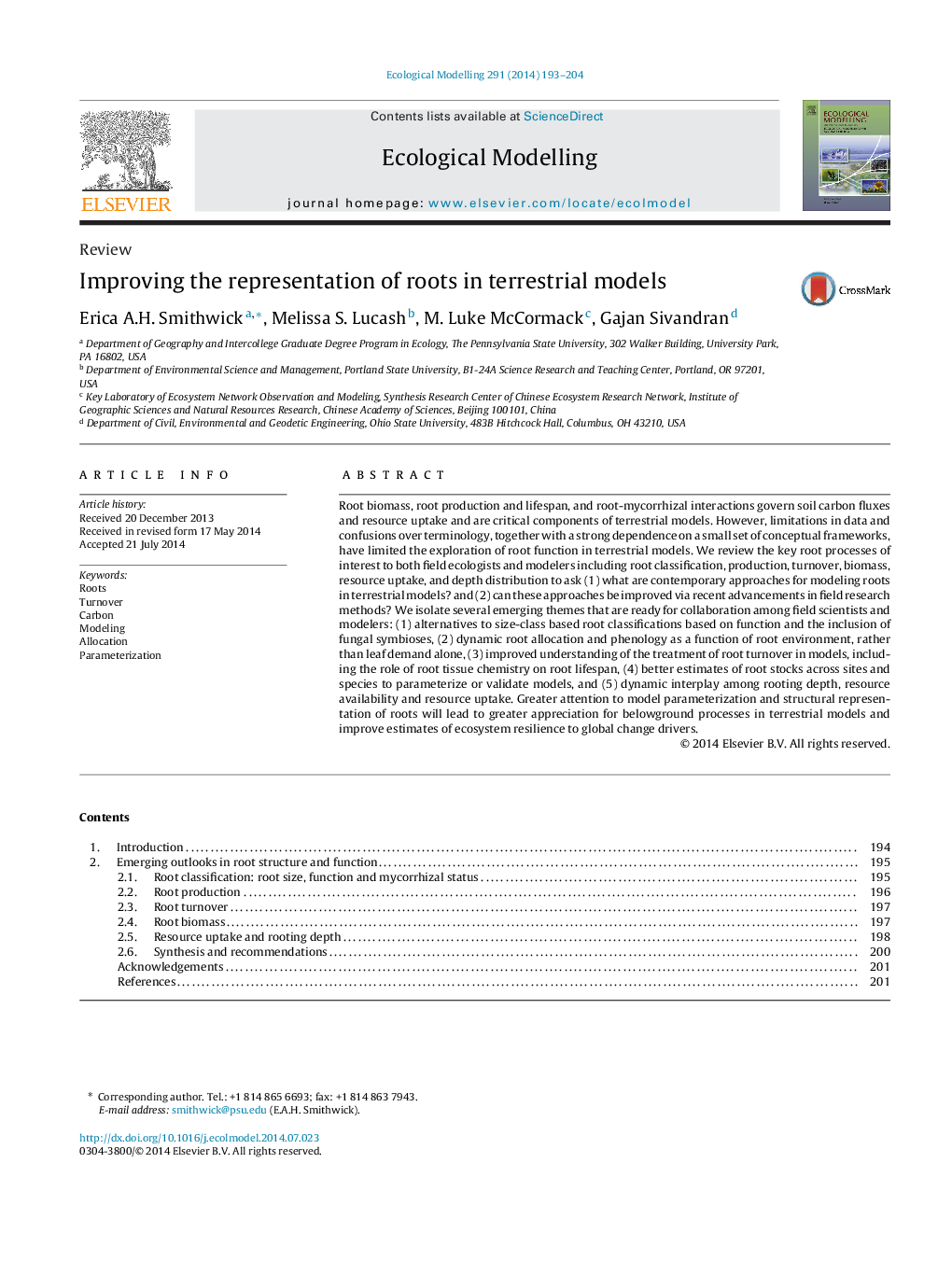| کد مقاله | کد نشریه | سال انتشار | مقاله انگلیسی | نسخه تمام متن |
|---|---|---|---|---|
| 6296766 | 1617455 | 2014 | 12 صفحه PDF | دانلود رایگان |
عنوان انگلیسی مقاله ISI
Improving the representation of roots in terrestrial models
ترجمه فارسی عنوان
بهبود نمایندگی ریشه ها در مدل های زمینی
دانلود مقاله + سفارش ترجمه
دانلود مقاله ISI انگلیسی
رایگان برای ایرانیان
کلمات کلیدی
ریشه ها، حجم معاملات، کربن، مدل سازی، اختصاص دادن، تنظیم پارامتر،
ترجمه چکیده
زیست توده ریشه، تولید ریشه و عمر، و تعاملات ریشه میکوریزا، شار کربن خاک و جذب منابع را کنترل می کند و جزء مهمی از مدل های زمین هستند. با این حال، محدودیت در داده ها و سردرگمی در مورد اصطلاحات و همچنین وابستگی شدید به مجموعه ای از چارچوب مفهومی، کاوش عملکرد ریشه را در مدل های زمینی محدود کرده است. ما پروسه های ریشه های کلیدی مورد توجه هر دو محیط شناسان و مدل سازان را از جمله طبقه بندی ریشه، تولید، گردش مالی، زیست توده، جذب منابع و توزیع عمق مورد بررسی قرار می دهیم (1) رویکردهای معاصر برای مدل سازی ریشه ها در مدل های زمینی چیست؟ و (2) آیا می توان این روش ها را از طریق پیشرفت های اخیر در روش های تحقیقاتی زمینه بهبود داد؟ ما چند مضمون در حال ظهور را که برای همکاری میان دانشمندان و مدلسازان حوزه آماده است، جداسازی می کنیم: (1) جایگزین های طبقه بندی ریشه بر اساس اندازه اندازه گیری بر اساس عملکرد و شامل ترکیب قارچی، (2) تخصیص ریشه پویا و فنولوژی به عنوان عملکرد ریشه محیط، به جای نیاز به برگ، به تنهایی، (3) درک بهتر از درمان گردش ریشه در مدل ها، از جمله نقش شیمی درخت ریشه در طول عمر ریشه، (4) برآورد بهتر از ذخایر ریشه در سایت ها و گونه ها برای پارامتر کردن و یا اعتبار مدل و (5) تعامل پویا در عمق ریشه، دسترسی منابع و جذب منابع. توجه بیشتر به پارامتر مدل و نمایش ساختاری ریشه ها منجر به ارتقاء بیشتر فرآیندهای زیر زمینی در مدل های زمینی و بهبود برآوردهایی از انعطاف پذیری اکوسیستم به رانندگان تغییر جهانی می شود.
موضوعات مرتبط
علوم زیستی و بیوفناوری
علوم کشاورزی و بیولوژیک
بوم شناسی، تکامل، رفتار و سامانه شناسی
چکیده انگلیسی
Root biomass, root production and lifespan, and root-mycorrhizal interactions govern soil carbon fluxes and resource uptake and are critical components of terrestrial models. However, limitations in data and confusions over terminology, together with a strong dependence on a small set of conceptual frameworks, have limited the exploration of root function in terrestrial models. We review the key root processes of interest to both field ecologists and modelers including root classification, production, turnover, biomass, resource uptake, and depth distribution to ask (1) what are contemporary approaches for modeling roots in terrestrial models? and (2) can these approaches be improved via recent advancements in field research methods? We isolate several emerging themes that are ready for collaboration among field scientists and modelers: (1) alternatives to size-class based root classifications based on function and the inclusion of fungal symbioses, (2) dynamic root allocation and phenology as a function of root environment, rather than leaf demand alone, (3) improved understanding of the treatment of root turnover in models, including the role of root tissue chemistry on root lifespan, (4) better estimates of root stocks across sites and species to parameterize or validate models, and (5) dynamic interplay among rooting depth, resource availability and resource uptake. Greater attention to model parameterization and structural representation of roots will lead to greater appreciation for belowground processes in terrestrial models and improve estimates of ecosystem resilience to global change drivers.
ناشر
Database: Elsevier - ScienceDirect (ساینس دایرکت)
Journal: Ecological Modelling - Volume 291, 10 November 2014, Pages 193-204
Journal: Ecological Modelling - Volume 291, 10 November 2014, Pages 193-204
نویسندگان
Erica A.H. Smithwick, Melissa S. Lucash, M. Luke McCormack, Gajan Sivandran,
